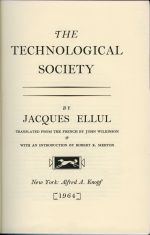
Topical Readings
Listed here are readings about Pauling, about chemistry, physics, molecular biology, and about science more generally; arranged chronologically by date of publication. The readings are intended to provide a historical and social context for the materials in the Ava Helen and Linus Pauling Papers. There are, of course, many other relevant books in the history of science collection in Special Collections, and in the general library collection. Call numbers preceded by "SpColl" are in Special Collections; other titles are in the general library collection.
Force of Nature: The Life of Linus Pauling, by Tom Hager. 1995. The best, most comprehensive biography available. Indispensable.
SpColl QD22.P35 H34 1995
Molecular Vision of Life, by Lily Kay. 1993. Selected chapters: Chapter 5, "1930-1940 and War." Chapter 6:
"CalTech, the Rockefeller Foundation, and the Role of the New Biology," on Pauling’s
move into molecular biology. Chapter 8, "Molecular Empire, 1946-1953," from p.256,
relates sickle-cell work and Pauling’s model building.
SpColl QH506.K39 1993
From Chemical Philosophy to Theoretical Chemistry. . .1800-1950, by Mary Jo Nye. 1993. Selected chapters: Chapter 1, "Scientific Disciplines: The
Construction of Identity." Chapter 2, "The Historical Demarcation of Chemistry and
Physics."
SpColl QD452.N94 1993
The Chemical Bond: Structure and Dynamics, Ahmed Zewail, ed. 1992. Selected chapters: Chapter 1, "X-Ray Crystallography and
the Nature of the Chemical Bond," by Linus Pauling. Chapter 4, "The Impact of Linus
Pauling on Molecular Biology: A Reminiscience," by Francis Crick. Chapter 5, "How
I Became Interested in the Chemical Bond: A Reminiscience," by Linus Pauling.
SpColl QD461.C422 1992
Molecules in Natural Science and Medicine: An Encomium for Linus Pauling, Zvonimir B. Maksic and Mirjana Eckert-Maksic, eds. 1991. A collection of essays
honoring Pauling.
SpColl QD461.M25 1991
Vitamin C and Cancer: Medicine or Politics?, by Evelleen Richards. 1991. A detailed analysis of the introduction of and response
to the idea of vitamin C therapy, with much information about Pauling.
SpColl RC271.A78 R53 1991b
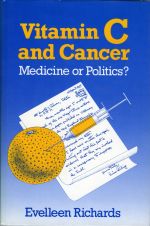
Vitamin C and Cancer: Medicine or Politics? by Evelleen Richards
LP Personal Library, RC271.A78 R53 1991b
Physical Chemistry from Ostwald to Pauling: The Making of a Science in America, by John W. Servos. 1990. Selected chapter: Chapter 6, "From Physical Chemistry to
Chemical Physics," section on "Linus Pauling: From Student to Teacher," pp. 275-298;
an account of the attempt to come up with a model of the atom that would resolve contradictions
between physical and chemical versions of the atom.
SpColl QD452.5.U6 S47 1990
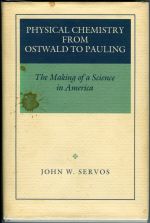
Physical Chemistry from Ostwald to Pauling: The Making of a Science in America, by John W. Servos
LP Personal Library, QD452.U6 S47 1990
Album of Science: The Physical Sciences in the Twentieth Century, Owen Gingerich, ed. 1989. A useful reference. Selected chapters: Chapter 2, "Atomic
Chemistry." Chapter 15, "How Atoms Unite."
SpColl Q125.G495 1989
The Roots of Molecular Medicine: A Tribute to Linus Pauling, Richard P. Huemer, ed. 1986. Includes an article by Pauling (Chapter 17) on "The
Future of Orthomolecular Medicine," and the listing (Chapter 18) by colleague Zelek
S. Herman of "The Twenty-five Most Cited Publications of Linus Pauling."
SpColl RM235.5.R66 1986
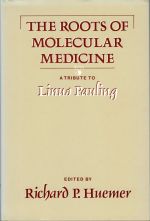
The Roots of Molecular Medicine: A Tribute to Linus Pauling, Richard P. Huemer, ed.
LP Personal Library, RM235.5 R66 1986
The Eighth Day of Creation: Makers of the Revolution in Biology, by Horace Freeland Judson. 1979. A comprehensive account of the beginnings and growth
of molecular biology. Selected chapter: Chapter 2, "‘DNA, you know, is Midas’ gold.
Everybody who touches it goes mad’." A portrait of Pauling, who came close to discovering
the molecular structure of DNA, but lost the race to Watson and Crick. Writing while
Pauling was still alive, Judson says (p.70), "No other American scientist now alive
compares with him."
SpColl QP624.J82 1980
An expanded edition is in the general library collection: QH506.J83 1996
Books which are included among those in Pauling’s personal library and available in the general library collection; a partial list only:
Linus Pauling: Scientist and Crusader By Florence Meiman White. 1980.
QD22.P35 W47 1980
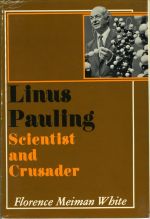
Linus Pauling: Scientist and Crusader, by Florence Meiman White
LP Personal Library, QD22.P35 W47 1980
The Social Responsibility of the Scientist, Martin Brown, ed. 1971.
Q125.S65
The Technological Society, by Jacques Ellul. 1964. Translated from the French.
T14.E5 1964
The Social Function of Science, by J.D. Bernal. 1939. John Desmond Bernal, an English crystallographer and left
thinker, was one of the first authors to systematically critique science n society;
this and approximately a dozen other titles by this author are available in the regular
library collection.
Q127.G4 B4
See also the OSU Libraries History of Science Subject Research Guide, for ways to search for more information on the historical and social context of science. Searching the library catalogue, OASIS, for the subject heading "orthomolecular therapy" will bring up titles that may be of interest in that particular area.
For example, a recommended reading list on topics related to nutrition would include:
- Cancer and Vitamin C, Cameron, Ewan and Linus Pauling. RC271.A78 C35 1993
- Linus Pauling and the Chemistry of Life, Hager, Thomas. Chapter 7: "Vitamin C". QP511.8.P37 H34 1998
- Vitamin C and Cancer, Richards, Eveleen. RC271.A78 R53
- Force of Nature: The Life of Linus Pauling, Hager, Thomas. Chapter 25: "Vitamin C" see also pp. 564-72. QD22.P35 H34 1995
- Linus Pauling in his Own Words. Marinacci, Barbara, ed. Part 4: "Nutritional Medicine 1954-1994". Q143.P25 A3 1995
(Also keep in mind videotapes and audiotapes as appropriate)
Table of Contents
- Introduction
- Ways to Approach the Curriculum
- Using Archival Materials in Special Collections
- Early Years: Education, Teaching and the Chemical Bond
- Middle Years: War Work, Peace Work and Protein Structure
- Later Years: Molecular Disease and Orthomolecular Medicine
- Topical Readings
- Websites Regarding Linus Pauling
- Appendix: General Guidelines for Use of Special Collections Materials
- Acknowledgements



